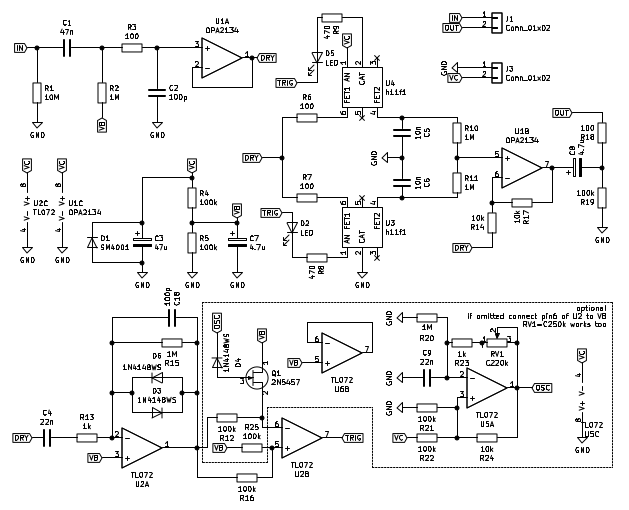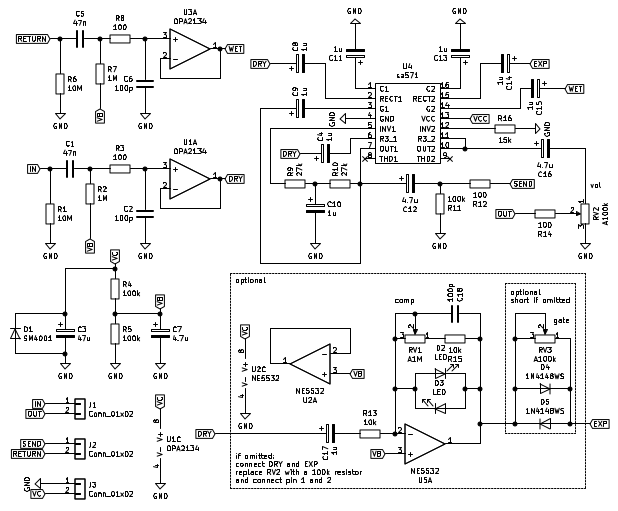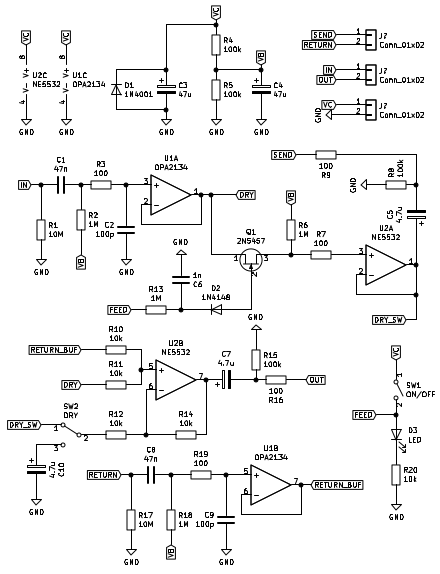garage driver
repo
this is a cute one: it's a push pull sample and hold thingy that is fed with the polarity of the derivative of the input, meaning whenever something interesting happens in the signal it is recorded, the rest is pure irregular quantisation distortion :D! i built something like this before and liked it a lot aside from noise floor issues, which is why i wanna go with opto fets. i could gate the control signal or put it inside an alc571, but i find it more interesting to make the circuit low noise in the first place.
the previous version was pretty fuzzy and retained nice clarity, paired well before and after other distortions. it also had the option to multiply the TRIG signal with another lfo carrier which was really cool, i'll sketch that up soon :). since it does not change the dynamics of the signal - it is not really a distortion, just a sample and hold after all - it can be used live with microphones for vocals or drums or stuff like that. i really wanna have one of those again, those were good times. shame i modded it to death.
update: patched in the oscillator. it should off with the speed dial maxed. you might wanna play around with the cap value to get a useable range, i just thumbed it there.
 pdf
pdf
while the opto fets reduce carrier bleed over the gate capacitance significantly, they might bleed into the power line; i think the 47u cap might be enough to catch that with reasonable layouting, but you could try bypassing the led driving tl072 supply with another 47u directly at the terminals if you encounter problems :). also proper driving transistors might be nicer than the led hack but on the other hand i guess it works like that too, and it simplifies troubleshooting! or use an opamp with a wider output range than the tl072, noise doesn't really matter. expect a bandwidth from ˜30-5000Hz, or more with proper led drivers.
also i should mention that it is totally an option to feed an analog signal to the TRIG terminal, or drive the leds independently or hook up a microcontroller or noise source or whatever, this is just a simple example and can be expanded a lot. plus i really like the idea of having a distortion pedal without any dials :D!
alc571
repo
this is a little helper for all effects that like constant input signals, like trackers of octavers, plls etc, but it can be used for other stuff too. the compressor/gate part is optional and honestly not very hifi, but it can add a nice grit.
the input signal is fed into a very high gain hard rms limiter, also known as an alc (automatic level control) that makes all inputs equal in volume, at least within its gain range. note that this means excessive noise may appear here as this will get amplified too. we don't care though; bear with me on that one.
this signal is then fed through the effect via the send/return loop. its output is then sent to a anti-alc unit that uses the same signal (for gain=0, gate=0) as its control signal. this means in theory, with matching rectifier caps and idealized components, the alc compression is perfectly reversed.
 pdf
pdf
in practise this is limited by side effects, most notably attack clipping: when the input signal is low, gain is very high and needs some time to decrease for a sudden big input, which clips the compressed signal for a short amount of time. since control signal and with it the anti-alc are unaffected by this clipping, the anti-alc doesn't readjust itself to the decreased volume of the clipped waveform during the attack phase, which may manifest as a slow attack.
this can be mitigated by either fancier circuit design which may or may not be a thing i will consider anytime soon, or by decreasing the rect caps and trade in faster reaction time by increasing ripple. the 1st order lpf cutoff freq is f[Hz]=16/C[uF]. this can be used for two side effects:
for cutoff frequencies within the audible range overtones of the input signal spectrum below cutoff appear. for example enhancing low frequencies below 80Hz with distortion could be done by using 100n for c11 and leaving c13 untouched.
/!\ if c13 is smaller than c11, this may lead very loud attack peaks. you might want to have an overdrive or smth behind that to catch high peaks, otherwise i think this can totally cause ear damage.
note that, since unlike in more typical root/square companders, the volume control signal is not encoded within the audio signal but just bypasses the inserted effect, a pulse input on a delay for example would be choked since the control signal is not delayed along with it and just turns up the return signal while input signal is present.
the compression is 1:inf, the gate is kinda hacked in but also kinda cute and could help with making choppy stuff.
also that's a lot of electrolytes but we want decent decoupling here :D. maybe i could calculate the hardclip rms voltage, i think i've done that at some point at it was something around 1Vrms.
spillover
repo
spillover: you turn off your reverb/delay, and the reflections of the last input before that still ring out normally. it's nice sometimes, as an option. not saying it's better, or that it actually matters; i don't think it does too much. but it's cool for having drones when turning up feedback for example.
this is by definition not possible with true bypass as it requires some sort of mixing circuit in bypass, but fortunately it's really easy to hack it in!
the circuit is as basic as it gets, the input of the room pedal gets signal as long as theswitch is in one position, its output is always mixed to the circuit's output. for pedals that can kill the dry signal the input may always be mixed to the output and provide a consistent dry sound.
if the pedal doesn't support dry kill, the internal dry must be killed if the pedal gets input; this is implemented by just substracting the send signal from the output mixer at all times. it's not perfect, but simple and also i like it.
 pdf
pdf


